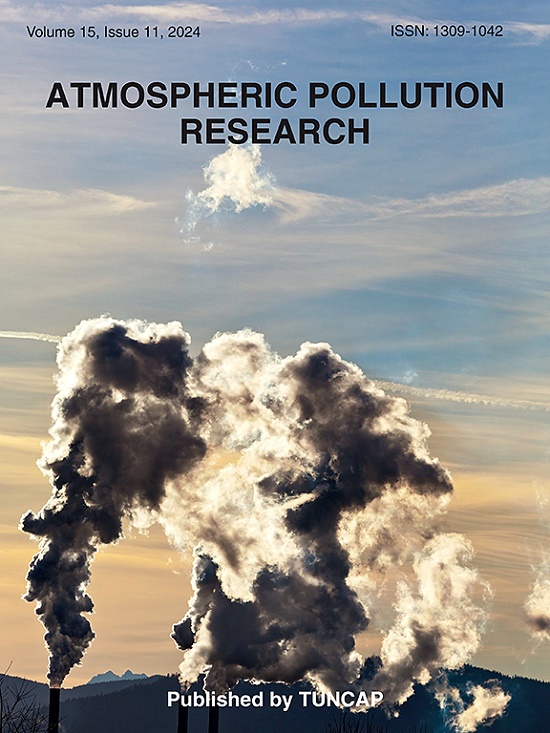中国南方高海拔山区MERRA-2黑碳气溶胶与地面观测的比较
IF 3.5
3区 环境科学与生态学
Q2 ENVIRONMENTAL SCIENCES
引用次数: 0
摘要
黑碳是大气气溶胶的重要吸光成分,在区域/全球气候和人类健康中起着至关重要的作用。与现有文献对城市BC气溶胶的主要关注不同,本研究基于长期(2008-2022)地面观测和海拔校正MERRA-2再分析,全面比较和研究了中国南方高海拔山区(庐山)BC浓度的时间变化。结果表明,观测值和MERRA-2年平均BC浓度均呈逐年下降趋势。然而,观测到的下降速率(- 0.115 μg m−3 yr−1)明显大于MERRA-2 (- 0.045 μg m−3 yr−1),这主要归因于MERRA-2在2013年后的静态排放清查。两个数据集都捕获了“v形”月变化模式,但MERRA-2高估了冬季BC 68%,低估了夏季BC 8%。MERRA-2的日变化与观测到的BC在冬季和夜间存在显著差异,但表现出一致的单峰分布,峰值出现在当地标准时间12:00 - 17:00之间。这种模式与在城市地区观察到的情况形成对比。结果表明,地面MERRA-2再分析与庐山观测结果的对比偏差大于台站高程匹配产品。这表明站高对BC浓度的时间变化有重要影响,在高海拔站点比较时,最好使用MERRA-2中与实际站高对应的模式级BC数据。这些结果可为MERRA-2 BC变化模式在高海拔地区的适用性和准确性提供参考。本文章由计算机程序翻译,如有差异,请以英文原文为准。

Comparison of MERRA-2 black carbon aerosols and ground observation at a high-altitude mountainous site in southern China
Black carbon (BC) is an important light-absorbing component of atmospheric aerosols and plays a crucial role in regional/global climate and human health. In contrast to the predominant focus on urban BC aerosols in existing literature, this study comprehensively compared and studied the temporal variations of BC concentration at a high-altitude mountainous site (Mt. Lushan) in southern China based on long-term (2008–2022) ground observations and elevation-corrected MERRA-2 reanalysis. Results indicate that both the observed and MERRA-2 annual mean BC concentrations show a downward trend over the years. However, the observed decline rate (−0.115 μg m−3 yr−1) is considerably larger than that of MERRA-2 (−0.045 μg m−3 yr−1), mainly attributed to MERRA-2's static emission inventory after 2013. Both datasets capture a “V-shaped” monthly variation pattern, but MERRA-2 overestimates winter BC by 68 % and underestimates summer BC by 8 %. Despite notable discrepancies during winter and at night, the diurnal variations of MERRA-2 and observed BC exhibit a consistent unimodal distribution, with its peak occurring between 12:00 and 17:00 local standard time (LST). This pattern contrasts with those observed in urban areas. A comparison reveals that using ground-level MERRA-2 reanalysis against the observation at Mt. Lushan results in larger biases than that using station elevation-matched product. This suggests that station elevation plays a significant role in the temporal variation of BC concentration, and it is preferable to use model-level BC data from MERRA-2 that corresponds to the actual station altitude for comparison at such high-altitude sites. These results could provide a referenced evaluation and promote the understanding on the applicability and accuracy of the MERRA-2 BC variation pattern over high-altitude sites.
求助全文
通过发布文献求助,成功后即可免费获取论文全文。
去求助
来源期刊

Atmospheric Pollution Research
ENVIRONMENTAL SCIENCES-
CiteScore
8.30
自引率
6.70%
发文量
256
审稿时长
36 days
期刊介绍:
Atmospheric Pollution Research (APR) is an international journal designed for the publication of articles on air pollution. Papers should present novel experimental results, theory and modeling of air pollution on local, regional, or global scales. Areas covered are research on inorganic, organic, and persistent organic air pollutants, air quality monitoring, air quality management, atmospheric dispersion and transport, air-surface (soil, water, and vegetation) exchange of pollutants, dry and wet deposition, indoor air quality, exposure assessment, health effects, satellite measurements, natural emissions, atmospheric chemistry, greenhouse gases, and effects on climate change.
 求助内容:
求助内容: 应助结果提醒方式:
应助结果提醒方式:


